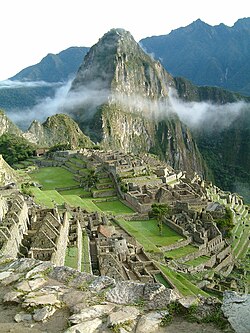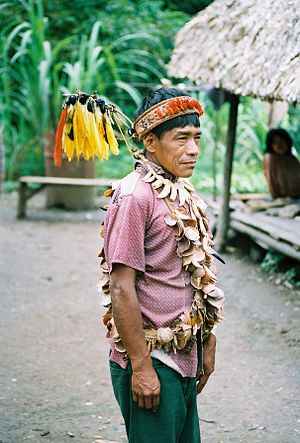Peru: Sovereign state in South America
Peru is a country in North, west South America.
The capital of Peru is Lima. The ruins of Machu Picchu, the Andes mountains, and the source of the Amazon River are all found in Peru.
Republic of Peru | |
|---|---|
| Motto: "Firme y feliz por la unión" (Spanish) "Firm and Happy for the Union" | |
| Anthem: "Himno Nacional del Perú" (Spanish) "National Anthem of Peru"
| |
| Gran Sello del Estado (Spanish) Great Seal of the State | |
 | |
| Capital and largest city | Lima 12°2.6′S 77°1.7′W / 12.0433°S 77.0283°W |
| Official languages | Spanish (Peruvian) |
| Co-official languages |
|
| Other languages |
|
| Ethnic groups (2017) | List of ethnic groups |
| Religion (2017) | List of religions
|
| Demonym(s) | Peruvian |
| Government | Unitary presidential constitutional republicunder semi-presidential system |
| Dina Boluarte | |
| Gustavo Adrianzén | |
| Legislature | Congress of the Republic |
| Independence from the Kingdom of Spain | |
• Declared | July 28, 1821 |
• Consolidated | December 9, 1824 |
• Recognized | August 14, 1879 |
| Area | |
• Total | 1,285,216 km2 (496,225 sq mi) (19th) |
• Water (%) | 0.41 |
| Population | |
• 2020 estimate | |
• 2017 census | 31,237,385 |
• Density | 23/km2 (59.6/sq mi) (198th) |
| GDP (PPP) | 2020 estimate |
• Total | |
• Per capita | |
| GDP (nominal) | 2020 estimate |
• Total | |
• Per capita | |
| Gini (2017) | medium |
| HDI (2018) | high · 82th |
| Currency | Sol (PEN) |
| Time zone | UTC−5 (PET) |
| Date format | dd.mm.yyyy (CE) |
| Driving side | right |
| Calling code | +51 |
| ISO 3166 code | PE |
| Internet TLD | .pe |


Peru is bordered to the north by Ecuador and Colombia, to the east by Brazil, to the south by Chile, and to the southeast by Bolivia. Peru is a representative democratic republic divided into 25 regions and over 33 million people live in it.
Peruvian territory was home to the Norte Chico civilization, one of the oldest in the world, and to the Inca Empire, the largest state in Pre-Columbian America.
The Spanish Empire conquered the region in the 16th century and established a Viceroyalty, which included most of its South American colonies. After achieving independence in 1821. The most popular religion in Peru is Christianity.
Peru suffered a terrible guerrilla war in the 1980s. The communist (Maoist) Shining Path tried to take over the country. But after the leader of the group was captured in 1992, Shining Path was not a threat anymore. During the 1990s, it was ruled by President Alberto Fujimori. During this time, the economy of Peru got better, and it became easier to start a company or operate a business. After Fujimori, Alejandro Toledo was elected president, and then Alan Garcia, who was president from 1985 to 1990, was elected again in 2006. Ollanta Humala was elected president in 2011 and Pedro Pablo Kuczynski was elected president in 2016. In March 2018, Kuczynski resigned following political scandals and Vice President Martín Vizcarra was sworn in as the next president.
Peru's most important exports, products that it sells to other countries, are fish, gold and other metals, oil, coffee, sugar, and cotton. Also, the food in Peru is very diverse, including typical dishes like Ceviche and Broiled Chicken.
Tourists from other countries like to come to Peru because of the history and also to enjoy nature. Many people come to climb mountains in the Cordillera Blanca in the Ancash Region, and many people visit Peru's long Pacific coast or the Amazon jungle. Cuzco and Machu Picchu are just two of the places where many buildings built by the Incas are still standing after hundreds of years, and these are some of the most visited places. The Incas were not the only tribe in Peru who left buildings and artifacts, but they were the most powerful.
Peru is divided into 25 regions of Peru regions. Lima is the capital and other main regions are Cuzco, Arequipa and Lambayeque.

In the Amazon jungle region, we can find many important rivers and different animals, plants and people of many indigenous cultures.
Peru includes 29.5 million people.
The currency of Peru is the Nuevo Sol.
Demographics
The population of Peru is approx. 30 million. The ethnic composition of Peru is:
Economy
As of 2018, about 22.3% of the population lives below the national poverty line
History
Peru was the home of the Inca Empire. The Incas were a well-organized Indian civilization that began the city of Cuzco (now called Cusco). Beginning in the 1400s, they defeated many nearby tribes and built an empire in the Andes. The Inca forced the people to work for the king for a certain number of days every year. They used this "work tax" to build roads and terraces on the sides of the mountains to grow crops, and huge cities with rich palaces for the rulers and their queens. Records were kept on quipa, knotted ropes, since the Incas never invented writing. These could be quickly sent anywhere in the empire by a series of relay runners set up along the roads. Heavier loads were sent by llamas, the pack animals of the Andes. The Incas were rich in gold and silver which could be found in the mountains. The Spanish wanted that treasure when they discovered the nation in the 1500s. Francisco Pizarro, a Spanish man, kidnapped and killed the Inca ruler in 1532, even after his people paid a huge amount of treasure for his release. The Incas fought the Spanish for many years, but the last Inca king was killed in 1572. Peru was a Spanish colony until 1821. Spanish is still the main language of the people, although many also speak Quechua, the Inca language.
Related pages
References
Notes
Other websites

- Peruvians in Germany Archived 2008-06-23 at the Wayback Machine
- Peruvian Directory of websites
This article uses material from the Wikipedia Simple English article Peru, which is released under the Creative Commons Attribution-ShareAlike 3.0 license ("CC BY-SA 3.0"); additional terms may apply (view authors). Content is available under CC BY-SA 4.0 unless otherwise noted. Images, videos and audio are available under their respective licenses.
®Wikipedia is a registered trademark of the Wiki Foundation, Inc. Wiki Simple English (DUHOCTRUNGQUOC.VN) is an independent company and has no affiliation with Wiki Foundation.


